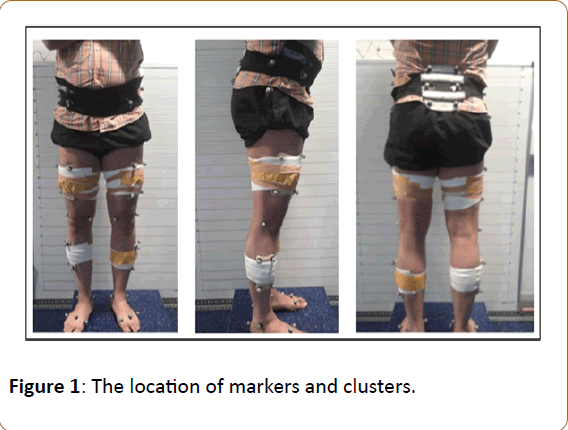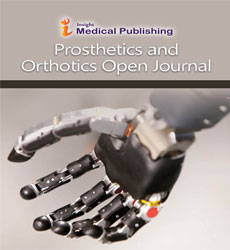Knee Joint Kinematics and Kinetics during the Force Plates Attachable Interlaced Stairway Climbing (FPAIS) in Healthy Individuals
Al-Fatafta HH12*, Liu AM2, Hutchins SW2 and Jones RK2
1Faculty of Rehabilitation Sciences, Department of Prosthetics and Orthotics, University of Jordan, Jordan
2School of Health Sciences, University of Salford, Manchester, Salford, UK
- *Corresponding Author:
- Huda Al-Fatafta, MSc, BSc
Office number 520, Faculty of Rehabilitation Sciences
Department of Prosthetics and Orthotics,
University of Jordan, Amman, 11942, Jordan
Tel: 00962780946488
E-mail: H.h.al-fatafta@edu.salford.ac.uk
Received date: October 16, 2017; Accepted date: November 07, 2017; Published date: November 14, 2017
Citation: Al-Fatafta HH, Liu AM, Hutchins SW, Jones RK (2017) Knee Joint Kinematics and Kinetics During the Force Plates Attachable Interlaced Stairway Climbing (FPAIS) in Healthy Individuals. Pros Orth Open J 1:15.
Copyright: © 2017 Al-Fatafta HH, et al. This is an open-access article distributed under the terms of the Creative Commons Attribution License, which permits unrestricted use, distribution, and reproduction in any medium, provided the original author and source are credited.
Abstract
Background: Two-stairway designs: force plate integrated stairway (FPIS) and force plates attachable interlaced stairway (FPAIS), have been used in gait laboratories in order to distinguish stair gait patterns between healthy and pathological groups and to assess the efficacy of different interventions for pathological groups especially with knee injuries. The previous studies evaluated the knee joint repeatability during stair climbing using FPIS design without evaluation the measurement error. Therefore, this study looked at the test and re-test repeatability of knee joint kinematics and kinetics in the sagittal; frontal; transverse planes during FPAIS stair climbing with measurement error calculation.
Method: Ten healthy (32.1 ± 6.8 years, five male, and five female) participants performed walking tests on the three stairs in two different sessions within a week.
Findings: The results showed high ICC’s for angles (ICC’s 0.83-0.99), and moments (ICC's 0.75-0.99). The SEM were up to 2.7° and 0.3 nm/kg and the RMSD were up to 4.1 ± 2.4° and 0.14 ± 0.10 nm/kg. Thus, reliability of the data showed moderate to excellent within healthy individuals. This result could provide an accurate baseline for pathological group in future studies which examines the orthotics impacts on knee joint kinematics and kinetics.
Keywords
Interlaced stairway; Repeatability; Knee biomechanics; Visual3d; Gait
Introduction
Since climbing stairs is an important daily activity and could be a challenge for some aged or ailing people, stairways have been designed for gait laboratories recently to discriminate between different pathologies and control groups, or to examine the benefit of using different orthotics interventions for pathological groups.
The test and retest reliability of using the force plate integrated stairway (FPIS) to examine lower limb kinematics and kinetics have been examined by some studies. Protopapadaki et al. (2007) investigated the knee joint kinematic and kinetic changes in sagittal plane during climbing four steps in 11 healthy subjects. The coefficient of variation (CV) result for knee flexion angle was 2.3% and 2.9%; knee flexion moment was 21.3% and 13.2%; and knee extension moment was 11.5% and 21.8% during stairs ascent and descent respectively [1].
In addition, Kowalk et al. reported the sagittal and frontal knee moment for ten healthy subjects and the variances ratios (VRs) demonstrated a good repeatability with VRs between 11%-14% [2]. McFadyen et al. examined the test and retest reliability of knee joint kinetics in sagittal plane of three healthy male subjects during climbing five steps, the CV results indicated that repeatability for the sagittal knee joint moment was between 15.8%-37.3% during stairs ascent and 19.5%-29.3% during stairs descent [3]. Another results evaluated the absolute repeatability of the knee join range of motion in the three planes by using the root mean square deviation (RMSD), the result was up to 3.6°, 1.5°, 2° during stairs ascent and up to 3.9°; 0.9°; 2° during stairs descent in sagittal, frontal and transverse planes respectively [4].
All of the previous studies have primarily used the FPIS staircase: those with embedded force platforms in the steps. The embedded force platform design is expensive, needs setting up at a particular space, and would not allow for a quick change over for a walking gait test to be performed. In order to overcome some of these issues, the force plate attachable interlaced stairway (FPAIS) design [5] was developed to measure force using the force platforms in a walkway with a firm fixation onto the force plates' surface. However, the assessment of the test and re test reliability of the knee joint kinematics and kinetics achieved from such a stair design has not been performed.
Additionally, previous studies mainly used the CV to calculate the data quality. Nevertheless, in many research projects Intraclass correlation coefficients (ICC) has been recommended for repeatability more than CV because the percentage expression of CV depends on the value of mean [6]. Also, using the standard error of measurement (SEM) and the root mean square deviation (RMSD) give more accurate measurement error.
Therefore, the purpose of this study was to evaluate the inter session repeatability and measurement error in knee joint kinematics and kinetics during stairs ascent and descent the FPAIS design and to measure SEM and RMAD. The outcome of the study will be important for identifying the knee repeatability in healthy individuals and to identifying the baseline for the therapist and the orthotists who evaluate the effect of orthotics interventions in pathology group using the force plate attached interlaced stairway (FPAIS)
Methods
Subjects
Ten healthy subjects (five male, five Female; age 32.1 ± 6.8 years; mass 69.3 ± 10.5 kg; height: 168 ± 7 cm) were tested in two separate sessions. The inclusion criteria were a good general condition with no any previous lower limb injuries or joint replacement. The study was approved by the University Research and Governance ethical committee and informed consent was obtained from each individual.
Experimental equipment
A three steps force plate attachable interlaced stairway (AMTI, Washington, USA) was fixed securely to two embedded AMTI force plates (model-BP600400, AMTI: Watertown, USA,) to capture force at an analogue sampling frequency of 1000 Hz. 16 infrared Qualisys Oqus cameras (Qualisys AB, Gothenburg, Sweden) with 100 Hz sampling rate were used to capture motion.
Subject preparation and procedure
Bare-feet participants with markers on the first, second and fifth metatarsal heads, Calcaneal tubercle, medial/lateral of malleolus and femoral epicondyle, greater trochanter, anterior/ posterior superior iliac spine, and iliac crest. Cluster pads were attached on lateral thigh, lateral shank and sacrum according to the CAST set technique (Figure 1) [7]. The data of five good trials of both ascent and descent on stairs at a self selected speed were examined. The test was repeated after one week under the same conditions.
Data management
Visual3D software (v 5.00, C-Motion Inc., Rockville, USA) was used. A Butterworth fourth-order bi-directional low pass filter with cut off frequencies of 6 Hz and 25 Hz for kinematics and analogue signals respectively [8] was used to filter the original data. A Cardan sequence of x-y-z was used to calculate kinetics data [9].
SPSS (version-20, IBM SPSS, Chicago, USA) was used to calculate the intraclass correlation coefficients (ICCs) type (3k) with 95% CI boundaries. Fleiss' classifications were used to interpret the value of ICCs [8]. The absolute repeatability was measured with SEM and RMSD.
Results
The ICC's of the knee angles in sagittal, frontal, and transverse planes were identified as 0.76-0.98 during stair climbing. The RMSD and SEM were up to 4.1 ± 2.4° and 2.7° respectively. Furthermore, the results show that the ICC of the knee moment in sagittal plane, frontal, and transverse planes were between 0.83-0.99. RMAD and SEM were up to 0.14 ± 0.10 nm/kg and 0.3 nm/kg respectively (Tables 1 and 2).
| Variable | Ascent Mean (± SD) (°) | Ascent ICC | 95% CI of ICC | SEM (°) | Descent Mean (± SD) (°) | Descent ICC | 95% CI of ICC | SEM (°) | ||
|---|---|---|---|---|---|---|---|---|---|---|
| Lower Bound | Upper Bound | Lower Bound | Upper Bound | |||||||
| Knee Adduction | 7.2 ± 10.0 | 0.965 | 0.858 | 0.991 | 1.9 | 10.6 ± 6.3 | 0.992 | 0.97 | 0.998 | 0.5 |
| Knee abduction | 13.6 ± 4.8 | 0.958 | 0.831 | 0.99 | 0.9 | 6.4 ± 8.5 | 0.996 | 0.984 | 0.999 | 0.5 |
| Maximum Knee flexion | 106 ± 7.5 | 0.963 | 0.849 | 0.991 | 1.4 | 12.1 ± 3.5 | 0.926 | 0.702 | 0.982 | 0.9 |
| Minimum sagittal knee | 11.2 ± 4.1 | 0.86 | 0.438 | 0.965 | 1.5 | 9.9 ± 4.5 | 0.902 | 0.67 | 0.976 | 1.4 |
| Knee medial rotation | 13.3 ± 3.4 | 0.973 | 0.893 | 0.993 | 0.5 | 12.5 ± 5.5 | 0.926 | 0.702 | 0.982 | 1.5 |
| Knee lateral rotation | 4.7 ± 7.8 | 0.879 | 0.513 | 0.97 | 2.7 | 8.0 ± 6.0 | 0.941 | 0.762 | 0.985 | 1.4 |
Table 1: The test and re-test reliability the knee joint kinetics variables with SEM.
| Variable | Ascent Mean (± SD) (Nm/Kg) | Ascent ICC | 95% CI of ICC | SEM (Nm/Kg) | Descent Mean (± SD) (Nm/Kg) | Descent ICC | 95% CI of ICC | SEM (Nm/ Kg) | ||
|---|---|---|---|---|---|---|---|---|---|---|
| Lower Bound | Upper Bound | Lower Bound | Upper Bound | |||||||
| Knee Adduction | 0.35 ± 0.28 | 0.869 | 0.484 | 0.968 | 0.1 | 0.08 ± 0.11 | 0.991 | 0.964 | 0.998 | 0.01 |
| Knee abduction | 0.07 ± 0.09 | 0.991 | 0.963 | 0.998 | 0 | 0.44 ± 0.23 | 0.983 | 0.931 | 0.996 | 0.03 |
| Knee flexion | 0.21 ± 0.58 | 0.968 | 0.872 | 0.992 | 0.1 | 0.18 ± 0.07 | 0.857 | 0.424 | 0.964 | 0.3 |
| Knee extension | 1.2 ± 0.19 | 0.836 | 0.448 | 0.966 | 0.07 | 1.05 ± 0.15 | 0.94 | 0.757 | 0.985 | 0 |
| Knee medial rotation | 0.17 ± 0.7 | 0.881 | 0.581 | 0.97 | 0.2 | 0.10 ± 0.05 | 0.946 | 0.781 | 0.986 | 0.01 |
| Knee lateral rotation | 0.01 ± 0.03 | 0.862 | 0.446 | 0.966 | 0.01 | 0.07 ± 0.04 | 0.959 | 0.836 | 0.99 | 0 |
Table 2: The test and re-test reliability the knee joint kinematics variables with SEM.
Discussion
In all previous repeatability studies on stairs, the FPIS design has primarily been used. The results attained in this study, as in previous studies 1-4 showed that the test and retest reliability of the variables in the sagittal plane was better than that in the frontal and transverse planes. However, all the results indicated moderate and excellent repeatability according to Fleiss' classifications [9]. This implies that this test is reliable, and would be perceived to be sensitive enough to detect any small changes and effects of any orthotics interventions for pathological groups.
The repeatability distinction between stairs ascent and descent could be explained by the uncontrolled speed during the test, as the uncontrolled speed could change the kinetics and gait pattern within the same session [10]. Additionally, as previous study 1, it could be due to the inconsistency of the ankle joint position when touched the step during ascending contributed to the outcome, and our results showed that ankle repeatability was less during ascending.
Conclusion
The results showed that the knee joint is highly reliable using the FPAIS design with a small measurement error in the three planes. This findings help the orthotists to determine the orthotic interventions' influence on knee kinetics and kinematics when stairs climbing. The limitations in this study could be uncontrolled speed although this does make it more generalizable, small group size, and extra steps should be added in future study to estimate the contra lateral side.
References
- Protopapadaki A, Drechsler WI, Cramp MC, Coutts FJ, Scott OM (2007) Hip, knee, ankle kinematics and kinetics during stair ascent and descent in healthy young individuals. Clin Biomech (Bristol, Avon) 22: 203-210.
- Kowalk DL, Duncan JA, Vaughan CL (1996) Abduction-adduction moments at the knee during stair ascent and descent. J Biomech 29: 383-388.
- McFadyen BJ, Winter DA (1988) An integrated biomechanical analysis of normal stair ascent and descent. J Biomech 21: 733-744.
- Husa-Russell J, Ukelo T, List R, Lorenzetti S, Wolf P (2011) Day-to-day consistency of lower extremity kinematics during stair ambulation in 24-45 years old athletes. Gait Posture 33: 635-639.
- Croce UD, Bonato P (2007) A novel design for an instrumented stairway. J Biomech 40: 702-704.
- Chinn S (1991) Statistics in respiratory medicine. 2. Repeatability and method comparison. Thorax 46: 454-456.
- Grood ES, Suntay WJ (1983) A joint coordinate system for the clinical description of three-dimensional motions: Application to the knee. J Biomech Eng 105: 136-144.
- Fleiss JL (1986) The design and analysis of clinical experiments. Wiley, New York, USA.
- Cappozzo A, Catani F, Croce DU, Leardini A (1995) Position and orientation in space of bones during movement: anatomical frame definition and determination. Clin Biomech (Bristol, Avon) 10: 171-178.
- Kean CO, Hinman RS, Bowles KA, Cicuttini F, Davies-Tuck M, et al. (2012) Comparison of peak knee adduction moment and knee adduction moment impulse in distinguishing between severities of knee osteoarthritis. Clin Biomech (Bristol, Avon) 27: 520-523.

Open Access Journals
- Aquaculture & Veterinary Science
- Chemistry & Chemical Sciences
- Clinical Sciences
- Engineering
- General Science
- Genetics & Molecular Biology
- Health Care & Nursing
- Immunology & Microbiology
- Materials Science
- Mathematics & Physics
- Medical Sciences
- Neurology & Psychiatry
- Oncology & Cancer Science
- Pharmaceutical Sciences

